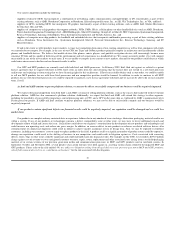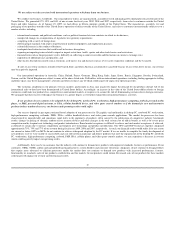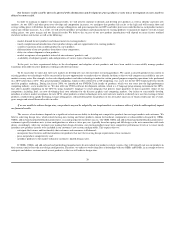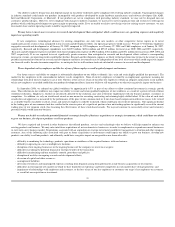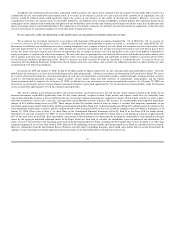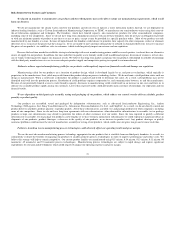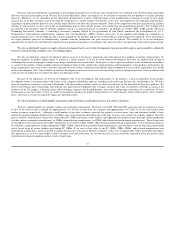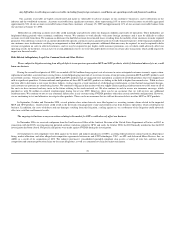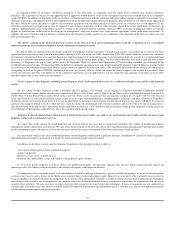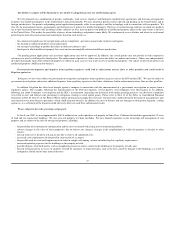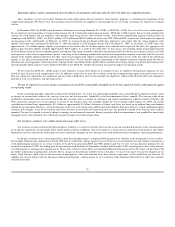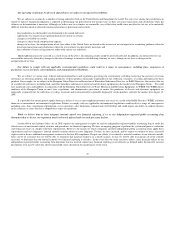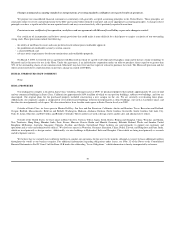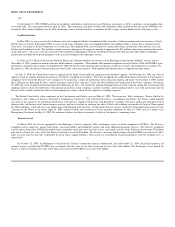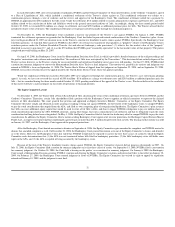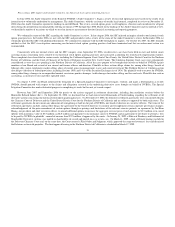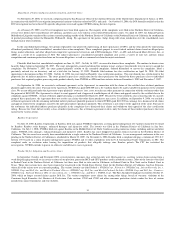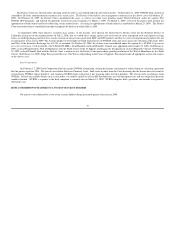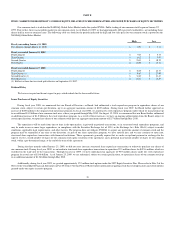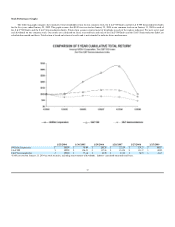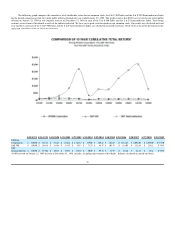NVIDIA 2008 Annual Report Download - page 31
Download and view the complete annual report
Please find page 31 of the 2008 NVIDIA annual report below. You can navigate through the pages in the report by either clicking on the pages listed below, or by using the keyword search tool below to find specific information within the annual report.
Expensing employee equity compensation adversely affects our operating results and could also adversely affect our competitive position.
Since inception, we have used equity through our stock option plans and our employee stock purchase program as a fundamental component of our
compensation packages. We believe that these programs directly motivate our employees and, through the use of vesting, encourage our employees to remain
with us.
In December 2004, the FASB issued Statement of Financial Accounting Standards No. 123(R), or SFAS No. 123(R)
,
Share
-
based Payment, which requires
the measurement and recognition of compensation expense for all stock
-
based compensation payments. SFAS No. 123(R) requires that we record compensation
expense for stock options and our employee stock purchase plan using the fair value of those awards. Stock
-
based compensation expense resulting from our
compliance with SFAS No. 123(R), was $162.7 million, $133.4 million and $116.7 million for fiscal years 2009, 2008 and 2007, respectively, which negatively impacted
our operating results. Additionally, on February 11, 2009, we announced that our Board of Directors approved a cash tender offer for certain employee stock
options. The tender offer commenced on February 11, 2009 and expired at 12:00 midnight (Pacific Time) on March 11, 2009. As of January 25, 2009, there were
approximately 33.1 million options eligible to participate in the tender offer. If all these options were tendered and accepted in the offer, the aggregate cash
purchase price for these options would be approximately $92.0 million. As a result of the tender offer, we may incur a non
-
recurring charge of up to approximately
$150.0 million if all of the unvested eligible options are tendered. This charge would be reflected in our financial results for the first fiscal quarter of fiscal year 2010
and represents stock
-
based compensation expense, consisting of the remaining unamortized stock
-
based compensation expense associated with the unvested
portion of the eligible options tendered in the offer, stock
-
based compensation expense resulting from amounts paid in excess of the fair value of the underlying
options, if any, plus associated payroll taxes and professional fees. We are currently tallying information on the number of options tendered under the offer to
determine the actual aggregate cash to be paid in exchange for the cancellation of the eligible options and the non
-
recurring charge to be incurred pertaining to the
unvested eligible options that have been tendered. We believe that SFAS No. 123(R) will continue to negatively impact our operating results.
To the extent that SFAS No. 123(R) makes it more expensive to grant stock options or to continue to have an employee stock purchase program, we may
decide to incur increased cash compensation costs. In addition, actions that we may take to reduce stock
-
based compensation expense that may be more severe
than any actions our competitors may implement and may make it difficult to attract retain and motivate employees, which could adversely affect our competitive
position as well as our business and operating results.
We may be required to record a charge to earnings if our goodwill or amortizable intangible assets become impaired, which could negatively impact
our operating results.
Under accounting principles generally accepted in the United States, we review our amortizable intangible assets and goodwill for impairment when events
or changes in circumstances indicate the carrying value may not be recoverable. Goodwill is tested for impairment at least annually. The carrying value of our
goodwill or amortizable assets may not be recoverable due to factors such as a decline in stock price and market capitalization, reduced estimates of future cash
flows and slower growth rates in our industry or in any of our business units. For example, during the twelve months ended January 25, 2009, our market
capitalization declined from approximately $14 billion to approximately $4 billion. Estimates of future cash flows are based on an updated long
-
term financial
outlook of our operations. However, actual performance in the near
-
term or long
-
term could be materially different from these forecasts, which could impact future
estimates. For example, if one of our business units does not meet its near
-
term and longer
-
term forecasts, the goodwill assigned to the business unit could be
impaired. We may be required to record a charge to earnings in our financial statements during a period in which an impairment of our goodwill or amortizable
intangible assets is determined to exist, which may negatively impact our results of operations.
Our stock price continues to be volatile and investors may suffer losses.
Our stock has at times experienced substantial price volatility as a result of variations between our actual and anticipated financial results, announcements
by us and our competitors, or uncertainty about current global economic conditions. The stock market as a whole also has experienced extreme price and volume
fluctuations that have affected the market price of many technology companies in ways that may have been unrelated to these companies
’
operating performance.
In the past, securities class action litigation has often been brought against a company following periods of volatility in the market price of its securities.
For example, following our announcement in July 2008 that we would take a charge against cost of revenue to cover anticipated costs and expenses arising from a
weak die/packaging material set in certain versions of our previous generation MCP and GPU products and that we were revising financial guidance for our
second fiscal quarter of 2009, the trading price of our common stock declined. In September, October and November 2008, several putative class action lawsuits
were filed against us relating to this announcement. Please refer to Note 12 of the Notes to Consolidated Financial Statements in Part IV, Item 15 of this Form 10
-
K
for further information regarding these lawsuits. Due to changes in the potential volatility of our stock price, we may be the target of securities litigation in the
future. Such lawsuits could result in the diversion of management
’
s time and attention away from business operations, which could harm our business. In
addition, the costs of defense and any damages resulting from litigation, a ruling against us, or a settlement of the litigation could adversely affect our cash flow
and financial results.
28


